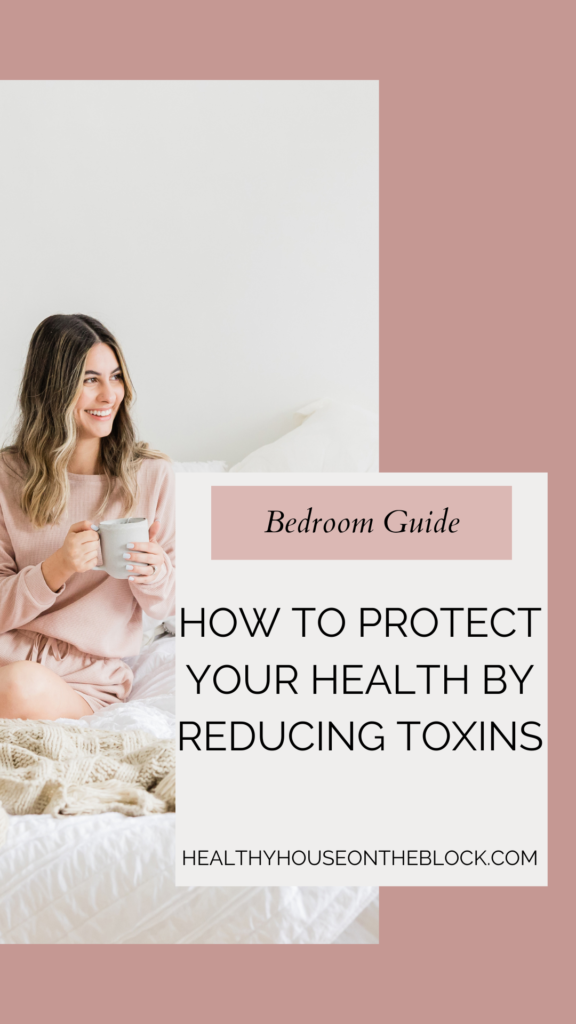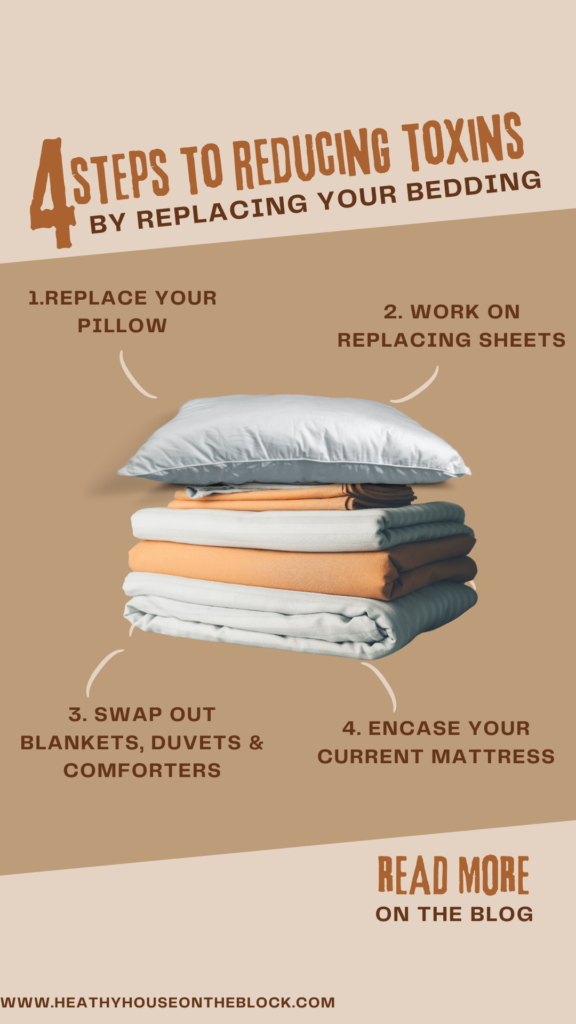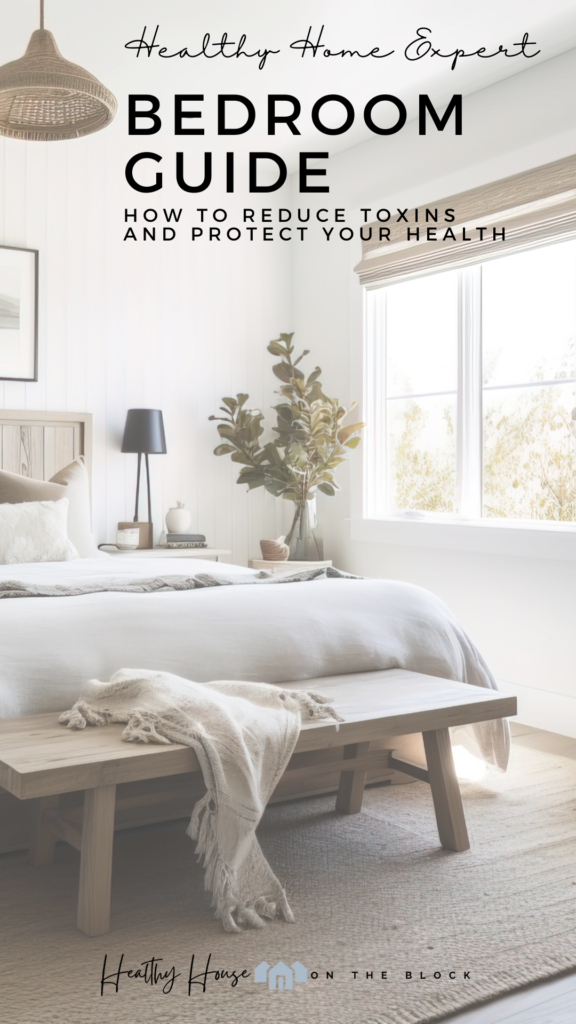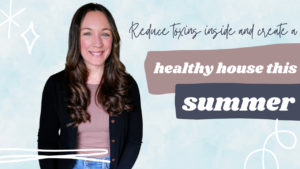
One of the biggest mistakes I see otherwise health minded families making ALL the time is they ignore healthy bedroom ideas and they don’t make the sleeping areas in their home a true priority in reducing toxins and making the space healthier.
And it makes sense, right? We live in a world where we sleep far less than we ever have in the past and so sleep and the room we sleep in has fallen to the wayside.
But what if you could improve your quality of sleep and feel better with improvements to your room and space. What if you could simply change the environment you sleep in to reduce toxin exposure, sleep better and function at a higher level all day long.
By taking these simple steps to change your sleeping space you can not only improve your sleep health, but you can improve your overall health as well.
Better sleep correlates to a healthier body.
WHY BEDROOM IDEAS COULD BE THE KEY TO BETTER HEALTH
One of the BIGGEST reasons so many products and articles focus on how to sleep is due to the fact that it’s extremely important to our health and wellness. We know those of us who suffer from poor or deficiency sleep have a greater risk of high blood pressure, diabetes, stroke, obesity, heart disease and kidney disease (STUDY)
And why does sleep matter so much? Sleep is one of the biggest contributors to a healthy lifestyle. When we get proper rest and sleep our body has time to repair itself from day to day stressors as well as detoxify the brain. When you’re rested you can function on a higher level. In fact this study revealed that sleep helps our brain and body flush out many of the toxins we come in contact with while we’re sleeping. (STUDY) Improving your sleep environment can drastically change the quality of your day.
It’s true that your house can cause insomnia. When we don’t know how to sleep in a healthy way, we deprive ourselves of this natural detoxifying habit, our health suffers. One study done associates poor indoor air quality with a disruption of sleep caused by small particles that get into our bloodstream. These particles then affect the regulation of sleep within our brain. (STUDY)
Another interesting study shows that household habits, materials and products can cause sleep disturbances, trouble falling asleep and chronic insomnia in adults and in children (STUDY). So what are the biggest factors when it comes to knowing the importance of how to sleep and creating a sleep sanctuary for your body?
- Controlling moisture levels and maintaining a healthy relative humidity level
- Removing and eliminating as much dust as possible
- Using low toxin bedding and pillows
- Opting for an organic mattress
- Keeping electronics out of your bedroom space
To go even deeper into healthy home bedroom ideas and get the step by step process I use with my clients, be sure to sign up for my new course, The Healthy Home Blueprint.

The Perfect Humidity Levels
Controlling the humidity in a bedroom is a great way to ensure organic toxins such as mold and mildew don’t affect your space. This bedroom idea is something you don’t want to ignore. Humidity is also important because an area that has high indoor humidity means higher levels of VOCs. Using bedroom ideas to reduce humidity levels in your bedroom also reduces the amount of VOCs that end up in your air. And when VOCs are in your air, you breathe them in constantly.
High humidity in an area where you’re staying for a long period of time can also cause congestion in many individuals. Nasal congestion is caused by inflamed blood vessels in the nose which cause swelling of nasal tissue. And if you’ve tried to fall asleep while being congested, you know that it’s not an easy task. Congestion can also cause snoring and mouth breathing which tend to be sleep disruptors. The fact that your house can cause insomnia and sleep deprivation means we need to be careful of the indoor climate.
The important thing to remember is that you don’t want to pull all the moisture out of your air. If your air is too dry your nasal passages, skin and eyes will be extremely itchy and irritated. We know that the ideal indoor humidity level is somewhere between 35% – 45%. You can monitor your humidity levels with a humidity monitor to see where your bedroom stands.
Bedroom ideas to reduce humidity in your space include:
- Open doors whenever possible to let air flow inside
- Move furniture away from vents to allow air to circulate through the room
- Wipe off window condensation if present
- Use a ceiling fan whenever possible
- Make sure adjoining bathrooms have properly vented fans to reduce moisture

Bedroom Ideas to Get Rid of Dust
Dust is everywhere, even if you feel like you have an extremely clean house. And where there’s dust, there’s sure to be dust mites. Bedrooms are a real problem spot when it comes to dust as we shed skin and sweat all when we’re sleeping on our mattress. This means that where humans spend the most time, there will be more dust. Most of the time we would just shrug this little fact off and perhaps vacuum a little bit more. But let me be the first to tell you this is NOT the way to handle extra dust in your bedroom.
Dust mites are a serious disruption to our bodies respiratory system and their skin and excrement are toxic to our bodies. So making sure your room has as little dust as possible is important.
Specifically speaking, dust mites cause an allergic reaction within our upper respiratory system such as a runny nose and hay fever. They also cause irritation in the lungs and eyes as well as sneezing. That doesn’t sound like the magic potion for sleep to me. The National Sleep Foundation also states that dust mites cause general immune system stress, which means you could be getting sick more often. These are all ways that dust and dust mites in your bedroom can really disrupt your sleep when you don’t practice this bedroom idea of reducing dust.

Reduce Toxins from Bedding in Phases
Toxins can be such a broad term. Specifically though, I’m talking about the toxins that are added to your bedding and pillows. We know that toxins are a disruptor to our endocrine system as well as an external irritant. Our endocrine system holds our thyroid and pineal gland, both are responsible for helping us fall asleep and stay asleep.
By allowing toxins from our bedding such as bleach, formaldehyde, flame retardants and pesticides to surround us for 7-8 hours a day, we are really overworking our immune system. This could lead to sleep disruptions that turn into sleep deprivation, or it could be insomnia.
Many of the chemicals that are added to our bedding and pillows such as polyurethane foams, formaldehyde (for a wrinkle free texture) and flame retardants release harmful VOCs constantly. When our bodies are in direct contact with these materials, producing both humidity and warmth, the VOCs actually off-gas at a higher, more potent rate.
I think it’s so important to remember that changing out bedding doesn’t have to be done immediately or all at once. Just like in the Healthy Home Blueprint, I like to break it down into easy to accomplish steps.
STEP 1: Replace your pillow. If you choose a latex pillow, make sure it’s using natural latex and organic cotton to encase it, like the Savvy Rest Pillow
Budget friendly bedroom idea: Get a pillow allergy cover to at least contain some of the toxins in your current pillow.
More information about different types of toxin free pillows can be found in this post.
STEP 2: Work on Replacing your sheets. The best thing to find for your sheets is an organic cotton sheet set. My top two picks are Grund Sheets and Savvy Rest Sheet Sets — all made from organic cotton.
Budget Friendly Bedroom Idea: If you’re on a tight budget, just opt for OKEO TEX 100 Cotton Sheet Set (You can get these anywhere, like Target). Otherwise, go for a completely organic

STEP 3: Swap out blankets and duvets and comforters. Look for completely transparent brands that you can purchase these items from. I am a huge fan of checking with brands that I’ve already researched and are willing to share openly what materials they use and how they make their products. Savvy Rest is one of my go-to brands and they have an extensive line of bedding. Sol Organics is another great spot if you’re looking for a comforter.
STEP 4: Encase your current mattress. Using a zipped cover to contain at least some of the toxins on your current mattress can help reduce toxin exposure while you sleep. While it may not help with toxins that are off-gassing, it will still help reduce toxins that will enter your dust or sleeping area through particles. My two favorite organic zipped protectors are from Savvy Rest (be sure to use my 20% off coupon HHOTB20) and Naturepedic.

Organic Mattress: The MOST important Change
Mattresses are IMPERATIVE when you’re trying to improve how to sleep. They are the BIGGEST factor when it comes to toxin prevention and can be one of the BEST options in terms of removing current toxins from your sleeping space.
If you google this topic you will find a plethora of blog posts and websites showing you the problems with the modern mattress and the toxins that are added to make it “safe.” When our hormones and brain function is disrupted by the toxins in a mattress THAT WE SLEEP DIRECTLY ON, there’s no telling what the effect could hold. This bedroom idea is a big ask, but it’s one worth expoloring.
The other side of that is the external irritants. Many of the chemicals in our mattresses can cause itchy throat and eyes as well as skin issues. These irritating conditions can make it very difficult to fall asleep.
The biggest offending toxins are the flame retardants they coat mattresses in. Initially this concept was added to prevent a fire if someone fell asleep with a cigarette in their mouth. Mattresses are covered in flame retardants now so they can withstand the heat and flame of a blow torch. Unless you’re sleeping with a blow torch nearby, it seems as though this practice may be unnecessarily causing some serious health issues. These same flame retardants were studied in a lab with mice. When the mice were exposed to the chemical toxins their brains became overly hyperactive. A hyperactive brain does not allow us to easily fall asleep, causing insomnia or sleep deprivation.
The other chemical offenders to where we sleep is the polyurethane foam they put in mattresses, which emits VOCs, a known endocrine system disruptor as well as an external irritant.
Formaldehyde has also been found in mattresses, which causes asthma, allergies and lung cancer. What we sleep on can be just as important as where we sleep when it comes to a healthy environment.
These toxins above are just the tip of the iceberg when it comes to our mattresses. This post about toxins in mattresses is a really in-depth look at just HOW these toxins are affecting our bodies with studies and links to back up that point.
The mattresses that I recommend are from totally transparent companies, like Savvy Rest. Their mattresses are made of organic materials like certified organic wool, certified organic cotton and natural latex foam. I love finding small businesses who really care about their products and their customers. Plus they’ve gone the extra mile to get the Greenguard Gold Certification and the GOTS certification for the mattress materials.
The Serenity Mattress is their best-seller and for good reason! Plus, you can use my coupon code (HHOTB20) for 20% off your purchase.

EMFs
Taking into account the fact that your house can cause insomnia and sleep disorders, there is a lot to be said for electromagnetic fields with this bedroom idea. While there is still a lot left unknown about EMFs, what we have learned is they are a disruptor to our bodies. There are two ways that EMFs disrupt our body’s natural sleep process.
First we must understand that our body has natural electromagnetic fields. Our natural EMFs vibrate at a low number of cycles. Electromagnetic fields from electronics vibrate at a higher rate of oscillation. The discrepancy between these two rates of humans and electronics is what can prevent you from falling asleep. They have also found that the higher vibrations of unnatural EMFs can pull you out of a deep sleep, which will disrupt your sleep process, leaving you tired. A study performed in 1999 showed that magnetic fields in the same room as a sleeping person caused a decreased time in REM sleep as well as a broken sleep pattern.
The same study also showed that the pineal gland’s production of melatonin, which helps you fall asleep, was decreased when individuals were exposed to more EMFs during the day. That’s right, your exposure to electromagnetic fields during the day can actually inhibit your sleep at night.
The other way that electronics and electromagnetic fields can disrupt your sleep is by the light given off by the electronics that create the EMFs. When you watch TV or look at your phone, your body’s natural response to the blueish light is to decrease the production of melatonin. Melatonin is what your pineal gland produces to help you fall asleep and stay asleep. This is why we sleep in dark rooms and why it’s generally easiest for us to fall asleep at night.
In the Healthy Home Blueprint, my online course, we look extensively at electronics in the bedroom, but essentially, the fewer electronics in your room the better.
If you absolutely cannot get electronics like phone chargers, sound machines or baby monitors out of your room, the second best thing is to have them as far away from your bed as possible.
Sometimes it even works to have chargers and baby monitors in a connected bathroom so you can still hear them, but they’re not in your space.
Whatever you do with this bedroom idea, make sure you keep electronics away from your head while you’re sleeping.

Learning how your house can keep you healthy is a great way to start changing your habits and lifestyle. We know now that your house can cause insomnia, sleep deprivation and other disturbances during sleep. We also know that sleep is one of the most important factors of a healthy lifestyle.
Our sleep allows us to function on a higher level, and also allows our brain to detoxify. Help your sleep by helping your sleep environment first with the bedroom ideas I outlined.



